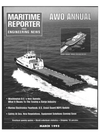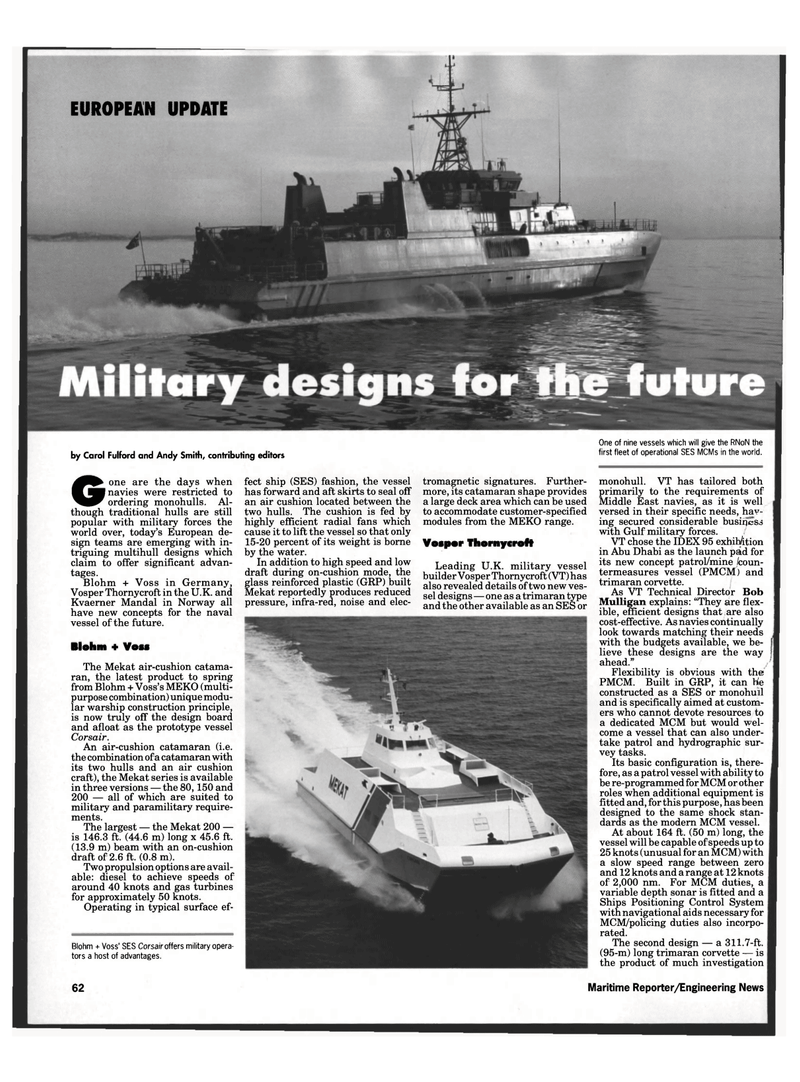
Page 60: of Maritime Reporter Magazine (March 1995)
Read this page in Pdf, Flash or Html5 edition of March 1995 Maritime Reporter Magazine
EUROPEAN UPDATE by Carol Fulford and Andy Smith, contributing editors
One of nine vessels which will give the RNoN the first fleet of operational SES MCMs in the world.
Gone are the days when navies were restricted to ordering monohulls. Al- though traditional hulls are still popular with military forces the world over, today's European de- sign teams are emerging with in- triguing multihull designs which claim to offer significant advan- tages.
Blohm + Voss in Germany,
Vosper Thornycroft in the U.K. and
Kvaerner Mandal in Norway all have new concepts for the naval vessel of the future.
Blohm + Von
The Mekat air-cushion catama- ran, the latest product to spring from Blohm + Voss's MEKO (multi- purpose combination) unique modu- lar warship construction principle, is now truly off the design board and afloat as the prototype vessel
Corsair.
An air-cushion catamaran (i.e. the combination of a catamaran with its two hulls and an air cushion craft), the Mekat series is available in three versions — the 80,150 and 200 — all of which are suited to military and paramilitary require- ments.
The largest — the Mekat 200 — is 146.3 ft. (44.6 m) long x 45.6 ft. (13.9 m) beam with an on-cushion draft of 2.6 ft. (0.8 m).
Two propulsion options are avail- able: diesel to achieve speeds of around 40 knots and gas turbines for approximately 50 knots.
Operating in typical surface ef-
Blohm + Voss' SES Corsair offers military opera- tors a host of advantages. feet ship (SES) fashion, the vessel has forward and aft skirts to seal off an air cushion located between the two hulls. The cushion is fed by highly efficient radial fans which cause it to lift the vessel so that only 15-20 percent of its weight is borne by the water.
In addition to high speed and low draft during on-cushion mode, the glass reinforced plastic (GRP) built
Mekat reportedly produces reduced pressure, infra-red, noise and elec- tromagnetic signatures. Further- more, its catamaran shape provides a large deck area which can be used to accommodate customer-specified modules from the MEKO range.
Voipar Thornycroft
Leading U.K. military vessel builder Vosper Thornycroft (VT) has also revealed details of two new ves- sel designs — one as a trimaran type and the other available as an SES or monohull. VT has tailored both primarily to the requirements of
Middle East navies, as it is well versed in their specific needs, hav- ing secured considerable business with Gulf military forces.
VT chose the IDEX 95 exhibition in Abu Dhabi as the launch pad for its new concept patrol/mine /coun- termeasures vessel (PMCM) and trimaran corvette.
As VT Technical Director Bob
Mulligan explains: "They are flex- ible, efficient designs that are also cost-effective. As navies continually look towards matching their needs with the budgets available, we be- lieve these designs are the way ahead."
Flexibility is obvious with the
PMCM. Built in GRP, it can He constructed as a SES or monohull and is specifically aimed at custom- ers who cannot devote resources to a dedicated MCM but would wel- come a vessel that can also under- take patrol and hydrographic sur- vey tasks.
Its basic configuration is, there- fore, as a patrol vessel with ability to be re-programmed for MCM or other roles when additional equipment is fitted and, for this purpose, has been designed to the same shock stan- dards as the modern MCM vessel.
At about 164 ft. (50 m) long, the vessel will be capable of speeds up to 25 knots (unusual for an MCM) with a slow speed range between zero and 12 knots and a range at 12 knots of 2,000 nm. For MCM duties, a variable depth sonar is fitted and a
Ships Positioning Control System with navigational aids necessary for
MCM/policing duties also incorpo- rated.
The second design — a 311.7-ft. (95-m) long trimaran corvette — is the product of much investigation 62 Maritime Reporter/Engineering News

 59
59

 61
61
